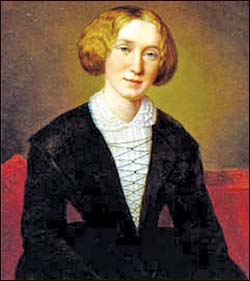Penning the difference
 Women
and men are usually depicted as having extremely different roles in
society, evident in the way both literature and the media portray them. Women
and men are usually depicted as having extremely different roles in
society, evident in the way both literature and the media portray them.
Since gender roles differ depending on society, culture, geographic
location, politics and time, the society in which people live plays an
enormous role in determining the expected patterns of behavior assumed
to follow from a personís sex.
Hence, gender differences are not natural, but they are seen as such
by the cultural components of society.
The role of women in religious scripture dictates an inferior
position in society. This phenomenon can be clearly viewed in many
religious literatures, prominently including the Holy Bible and various
Buddhist literatures.
|

Gajaman Nona |
|

George Eliot |
The creation of Adam and Eve and Eveís persuasion of Adam to eat the
forbidden apple from the tree of knowledge lead us to think that woman
was the cause of the first punishment given to mankind.
On the other hand a Jataka story like Andhabhutha Jathakaya provides
rather a rigid and stern view over womankind. According to Andhabhutha
Jathakaya, women cannot be protected from sin though they have been
closely watched since they have been in their mothersí womb.
This origin provides the ground work for inequality of genders on the
basis of religious scripture. The roles prescribed determined that women
should be in a subordinate position to man.
We, as Sri Lankans depict gender roles in literature as well as
general purposes in most traditional ways.
The mother is typically portrayed as cooking for her family, the
female child is seen as helping her mother in the kitchen, whereas the
father is depicted as sitting in a comfort-able armchair, reading the
newspaper, and the male child is seen as busy playing. And as we are in
a patriarchal society, father is always considered as the breadwinner,
and male domination can be often seen literarily depicted.
Literature plays a major role in constructing gender roles and in
presenting the image of the girl as a woman, and the boy as a man that
has different roles. I wonder why most prominent evil characters of
fairy tales are depicted by women.
Most step mothers as well as witches in many tales lead me to that
conclusion. Heroic male figures dominate most childrenís books and the
female character can only be saved with the help of a prince, or a male
figure.
In other words, girls are taught to be sweet, naÔve, passive,
self-sacrificing sisters and daughters that are eventually dependent on
the support of the male figure, whereas boys are encouraged to be
strong, adventurous, self-sufficient heroes and saviors. Many popular
stories and fairy tales tend to reflect stereotypes of masculine and
feminine roles.
Even when females are initially represented as active and assertive,
they are often seen in a passive light.
In early days, emerging in the literary field as a woman writer was
not an easy task. That is why a woman writer such as Mary Anne Evens had
to choose a male pen name as George Eliot.
Critics and so called intellectuals have excluded women and womenís
writing from both participation and consideration within the literary
circle.
Only individuals who are determinedly partisan could have for
centuries practised a double standard which judged the woman writer as a
true woman and the man writer was a true writer; only individuals who
are in control and who wish to stay that way could have consistently
refused to admit the part they were playing in keeping women out of the
world of letters. Whether it is George Eliot or Gajaman Nona, still they
exist in readersí hearts, amidst of all the obstacles they had to face. |



